Abstract
The article is devoted to the study of the relationship between the level of physical activity and self-rated health of school-aged children. The issues of the influence of physical activity on various indicators of the physical, mental and social components of health are widely studied now. The results of a number of studies reveal that the components of the health of school-aged children have a significant relationship with indicators of physical activity and physical fitness. However, the question of the nature of the relationship between physical activity and self-assessment of indicators characterizing the health of schoolchildren remains insufficiently studied. The data presented in the article were obtained during the 2017/2018 research cycle of the cross-national HBSC study in the Russian Federation. Follow indicators were selected for the study: the indicator of physical activity from moderate to vigorous intensity, and a group of indicators characterizing schoolchildren's self-esteem of health, mood, sleep quality, activity and emotional state. School-aged children engaged in physical activity for at least an hour 7 times a week more positively assess their health, mood, sleep quality, activity and emotional state. The next task is to clarify whether this phenomenon is an indicator of their general positive attitude as a result of a higher level of physical activity, or their health is actually better due to a higher level of physical activity.
Keywords: Physical activityself-related healthadolescents
Introduction
Many people realize the benefits of exercise for health and well-being, but by no means all make daily physical training and sports a part of their life. At the same time, the WHO pays the closest attention to proper nutrition and physical activity from moderate to vigorous intensity for at least 60 minutes every day, since these two components can take the health of both children and adults to a qualitatively new level and prevent some non-communicable diseases, such as, for example, cardiovascular diseases or diabetes.
Assessment of the impact of physical activity on the growth and development of adolescents has already long attracted researchers; in recent decades, this topic has become especially relevant due to adolescents' passion for low-active kinds of activities, active introduction of the information environment and virtualization of many areas of adolescent communication ( Koroleva et al., 2014). Physical activity is believed to be an important determinant of health status, including functioning of the cardiovascular system, skeletal integrity and psychological well-being ( Kleszczewska et al., 2017). Health self-assessment (HSA) is a widely studied indicator among adults and the elderly, but is not often studied in adolescents; however, it is at this age that the perception of health self-assessment develops ( Malta et al., 2018; Wade & Vingilis, 1999).
Problem Statement
The recent years have witnessed an increasing interest of researchers in the problem of self-rated of adolescent health. For example, the studies by Fyodorov and Erlikh ( 2016) determined the distinctive features of the phenomenon of “adolescent health” based on the analysis of the behavioral and psychosocial factors of adolescent health, including self-rated health, medical awareness, position of health in the system of life values, harmful habits, environmental attitudes, stress factors and physical activity ( Fyodorov & Erlikh, 2016). The longitudinal studies by Crocker et al. ( 2006) to assess the relationship of the physical self-concept with the behavior and emotions in adolescent girls showed that specific physical self-awareness is an important predictor of physical activity.
The studies by Norwegian scientists Breidablik et al. ( 2008) involving 2800 adolescents and using regression analysis have shown that adolescents conceptualize health as a construct related with medical, psychological, social factors and lifestyle. The results of the Russian-British comparative study by Hagger et al. ( 1998) evidence the children’s ability to distinguish four different aspects in the field of physical self-worth (PSW): perceived sports competence (Sport), physical fitness (Condition), attractiveness of the body (Body) and physical strength (Strength). Similar approaches were used in the studies by Biddle et al. ( 1993), where four subdomains of physical self-worth were used based on factor analysis: sports competence, body attractiveness, perceived strength and physical condition. The studies by Inchley et al. ( 2011) emphasize the importance of physical self-perception in relation to the behavior of adolescents involved in physical activities. For example, among adolescent boys, the high perceived competence increased physical activity 3.8 times. Among older girls, the high self-efficacy of physical exercises increased physical activity 5.2 times. The results of the study by Raudsepp et al. ( 2002) show that physical self-awareness is a significant correlate of physical activity and physical fitness in children and adolescents.
Thus, since self-assessment of physical and psychological components of health is formed in childhood and adolescence, and its development has not been studied to a large extent, further understanding and study of this topic (problem) is required.
Research Questions
Correlation between physical activity and self-rated health of school-aged children.
Age-related characteristics of physical activity and self-rated health of school-aged children.
Presence of gender differences in the self-assessment of the studied indicators.
Purpose of the Study
To reveal the relationship between the indicators of the level of physical activity and schoolchildren’s self-rated health.
Research Methods
Taken as the basis were the data of the international study “Health Behaviour in School-aged Children” for the 2017/2018 research cycle in Russia ( Gavrilov et al., 2018). The research is conducted every four years and provides a range of indicators of the health and well-being of children and adolescents of 11, 13 and 15 years of age based on the schoolchildren’s responses to the questionnaire ( Inchley et al., 2020). Two indicators were selected for the study: the indicator of physical activity from moderate to vigorous intensity, and the indicator of the schoolchildren’s self-rated health. The consideration of the PA indicator involves two groups of students of 11, 13 and 15 years of age: the first group is schoolchildren whose level of physical activity meets the WHO recommendations: PA from moderate to vigorous intensity for at least 60 minutes a day, seven days a week (11 y.o. (girls n=112, boys n=154); 13 y.o. (girls n=75, boys n=124); 15 y.o. (girls n=92, boys n=152). The second group is the schoolchildren practicing PA for at least an hour three times a week (that is, in fact, they only attend physical education classes at school) (11 y.o. (girls n=140, boys n=130); 13 y.o. (girls n=217, boys n=162); 15 y.o. (girls n=289, boys n=203). The schoolchildren were asked the following question about the level of physical activity: “Over the past 7 days, on how many days were you physically active for a total of at least 60 minutes per day?” The question regarding the self-rated health by schoolchildren was as follows: “Would you say your health is...?”. In this case, only one of the answer options was taken into account, namely “excellent” (other answer options: “good”, “fair”, “poor”). Thus, the study allows tracing the relationship between the regularity of physical activity and schoolchildren's assessment of their health as excellent.
Findings
Depending on the level of physical activity the adolescents were preliminarily divided into two groups:
MVPA 3 – adolescents engaged in PA for at least an hour 3 times a week;
MVPA 7 - adolescents engaged in PA for at least an hour 7 times a week;
The reliability of the differences of the responses in MVPA3 and MVPA7 groups was compared by using the nonparametric Mann–Whitney U-test.
Our attention was drawn to the questions of the questionnaire rather evidencing the psycho-emotional components of health. Since adolescence is known to have specific features related with emotional instability and motivation ( Puhov et al., 2020).
Our research has shown that when answering the question “Would you say your health is...?” the overwhelming majority of 11-15-year-old adolescents of the MVPA 7 group rate their health status as excellent, and the boys' self-assessment in this indicator is higher than that of girls and tends to decrease with the increase of the age from 11 to 15 years (from 64.7 to 58.3%, respectively) (Figure
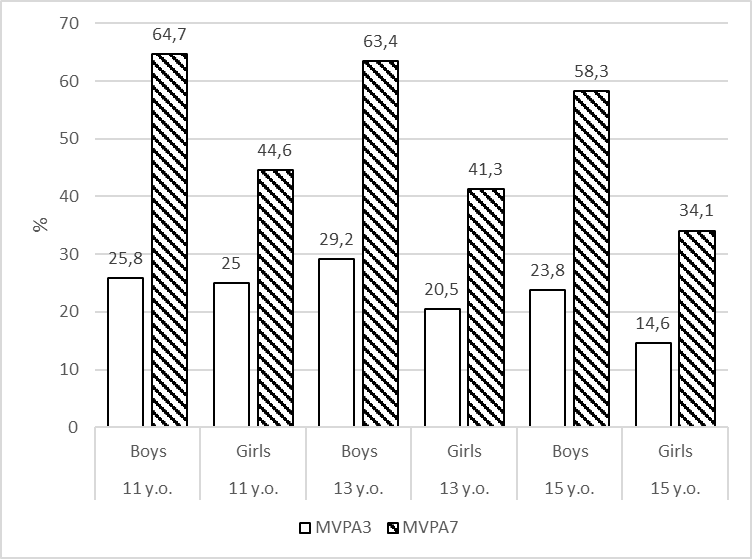
Please replace this text with context of your paper. In the MVPA 3 group of adolescents, the results on this issue are 2-2.5 times lower; with boys the maximum percentage is shown in the group of 13-year-old adolescents (29.2%), girls show lower self-rated health, and the indicator decreases with the increase of the age from 11 to 13 years, the indicator decreases (from 25% at 11 years to 14.6% at 15 years).
When responding to the statement “My sleep was restless” (Figure
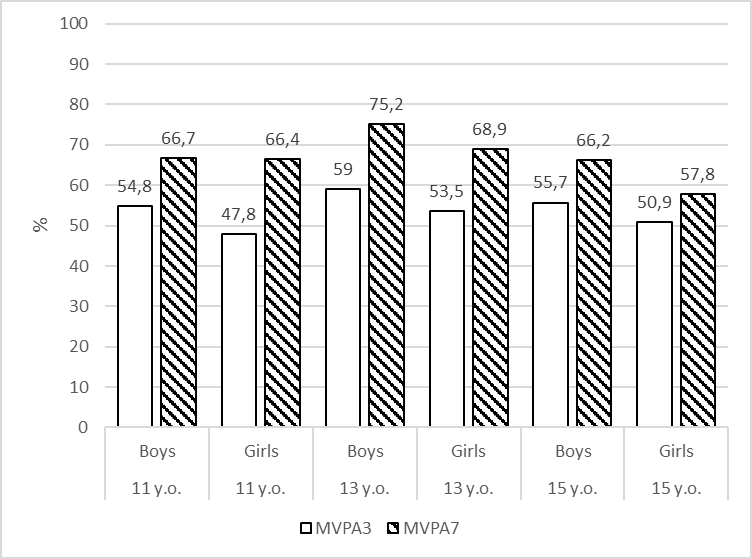
With the answer “All of the time (5-7 days)” to the statement “I was happy” (Figure
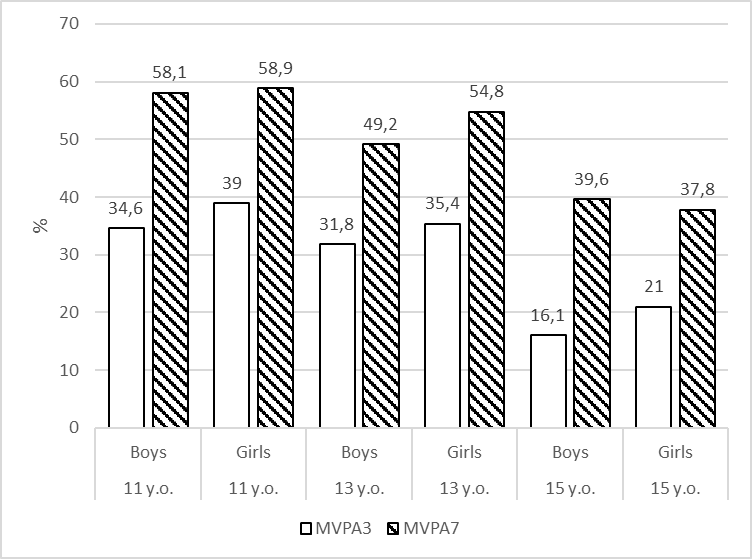
The values in MVPA 3 group are 1.5-2 times lower compared to MVPA 7 group. There is a downward trend in the percentage of respondents with the age increase both among boys (from 34.6% of 11-year-old boys to 16.1% 15-year-old adolescents) and girls (from 39% of 11-year-old girls to 21% of 15-year-old girls).
When responding to the statement “I have felt cheerful and in good spirits” (Figure
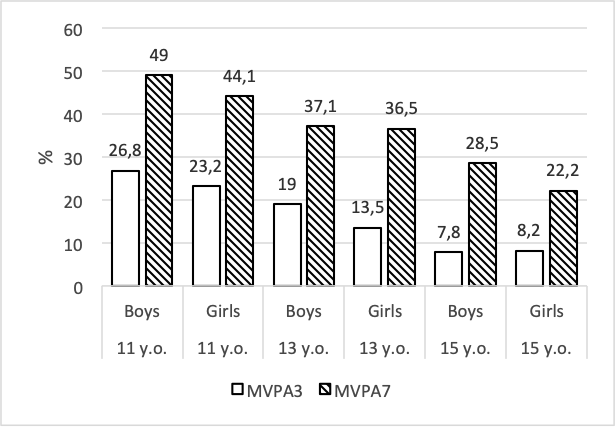
The differences between MVPA3 and MVPA7 groups are significant for boys and girls (p <0.01)
When responding to the statement “I have felt active and vigorous” all of the time (Figure
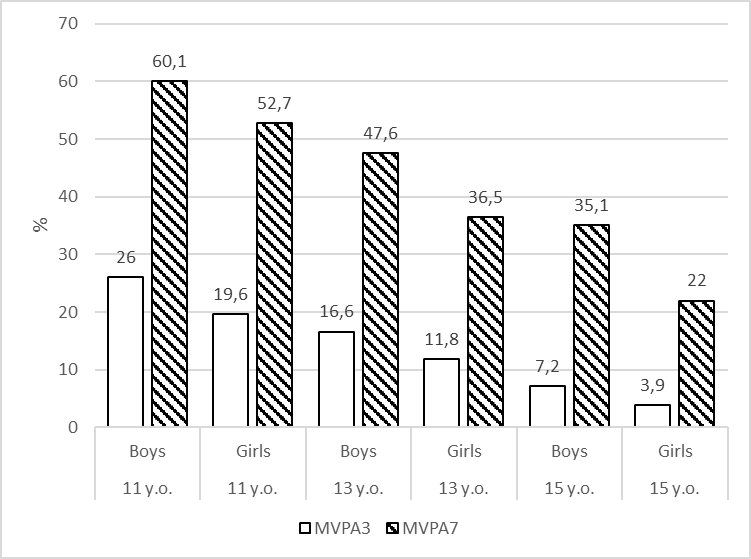
Conclusion
Children who are more physically active are more likely to report that their health is excellent, they usually feel cheerful and in good spirits, active and vigorous all of the time (reliable in most cases) compared to their less physically active peers. Physical activity has a positive impact on adolescents’ health and can be used as health promotion means. The next task is to clarify whether this phenomenon is an indicator of their general positive attitude as a result of a higher level of physical activity, or their health is actually better due to a higher level of physical activity.
References
- Biddle, S., Page, A., Ashford, B., Jennings, D., Brooke, R., & Fox, K. (1993). Assessment of Children's Physical Self-Perceptions. International Journal of Adolescence and Youth, 4(2), 93-109.
- Breidablik, H. -J., Meland, E., & Lydersen, S. (2008). Self-rated health in adolescence: A multifactorial composite. Scandinavian Journal of Public Health, 36(1), 12-20. https://doi.org/10.1177/1403494807085306
- Crocker, P. R. E., Sabiston, C. M., Kowalski, K. C., McDonough, M. H., & Kowalski, N. (2006). Longitudinal assessment of the relationship between physical self-concept and health-related behavior and emotion in adolescent girls. Journal of Applied Sport Psychology, 18(3), 185-200.
- Fyodorov, A., & Erlikh, C. (2016). Health behavioral factors in modern adolescents. Journal of Physical Education and Sport, 16(1), 109-112.
- Gavrilov, D. N., Antipova, E. V., Malinin, A. V., Puhov, D. N., Matochkina, А. I., & Savenko, М. А. (2018). Physical activity and its impact on schoolchildren’s health. Theory and practice of physical culture, 11, 44-47.
- Hagger, M., Ashford, B., & Stambulova, N. (1998). Russian and British children's physical self-perceptions and physical activity participation. Pediatric Excercise Science, 10(2), 137-152.
- Inchley, J., Kirby, J., & Currie, C. (2011). Longitudinal changes in physical self-perceptions and associations with physical activity during adolescence. Pediatric Exercise Science, 23(2), 237-249.
- Inchley, J., Currie, D., Budisavljevic, S., Torsheim, T., Jåstad, A., Cosma, A., Kelly, C., & Arnarsson, A. (2020). Spotlight on adolescent health and well-being. Findings from the 2017/2018 Health Behaviour in School-aged Children (HBSC) survey in Europe and Canada. International report. Volume 1. Key findings. WHO. Copenhagen, Denmark.
- Kleszczewska, D., Dzielska, A., Nałęcz, H., & Mazur, J. (2017). Physical activity, BMI and body weight perception among 15-year-old boys and girls in Poland in the light of international comparisons. Developmental period medicine, 21(3), 235-247.
- Koroleva, N. N., Bogdanovskaya, I. M., & Lugovay, V. F. (2014). The impact of the modern information and media environment on the "self image" of teenagers. UNIVERSUM: Bulletin of Herzen University, 2, 87-94.
- Malta, D. C., De Oliveira, M. M., Machado, I. E., Prado, R. R., Stopa, S. R., Crespo, C. D., & Assunção, A. Á. (2018). Characteristics associated to a poor self-rated health in Brazilian adolescents, National Adolescent School-based Health Survey. Revista Brasileira de Epidemiologia, 21, E180018.supl.1.
- Puhov, D. N., Malinin, A. V., & Shustin, B. N. (2020). Motivational preferences of school-aged children in the types of physical activity and sport. Theory and practice of physical culture, 7, 36-38.
- Raudsepp, L., Liblik, R., & Hannus, A. (2002). Children's and adolescents' physical self-perceptions as related to moderate to vigorous physical activity and physical fitness. Pediatric Exercise Science, 14(1), 97-106.
- Wade, T. J., & Vingilis, E. (1999). The development of self-rated health during adolescence: An exploration of inter- and intra-cohort effects. Canadian Journal of Public Health, 90(2), 90-94.
Copyright information

This work is licensed under a Creative Commons Attribution-NonCommercial-NoDerivatives 4.0 International License.
About this article
Publication Date
09 October 2022
Article Doi
eBook ISBN
978-1-80296-949-8
Publisher
European Publisher
Volume
1
Print ISBN (optional)
-
Edition Number
1st Edition
Pages
1-95
Subjects
Health psychology, psychology, health systems, health services, social issues, teenager, children's health, teenager health
Cite this article as:
Lukmanova, N., Malinin, A., Matochkina, A., & Puhov, D. (2022). Physical Activity And Self-Rated Health: Social Issue. In M. Jaworski (Ed.), Health & Health Psychology - icH&Hpsy 2020, vol 1. European Proceedings of Health (pp. 44-50). European Publisher. https://doi.org/10.15405/eph.20101.8

